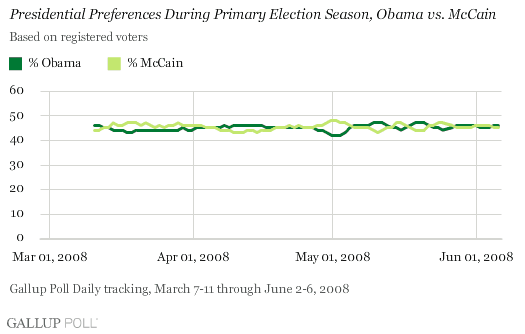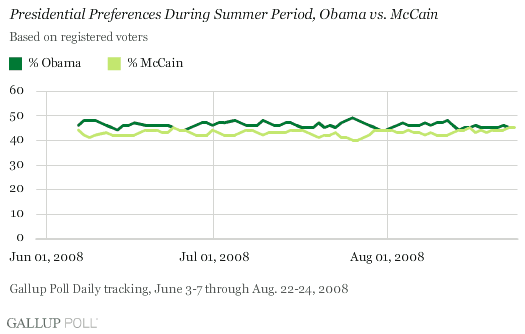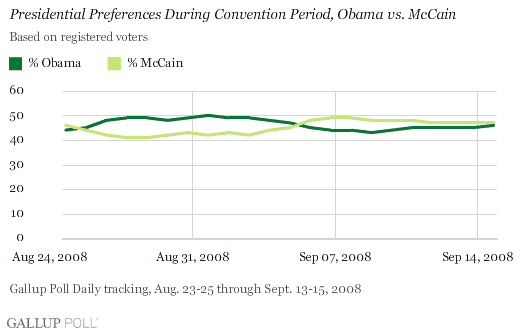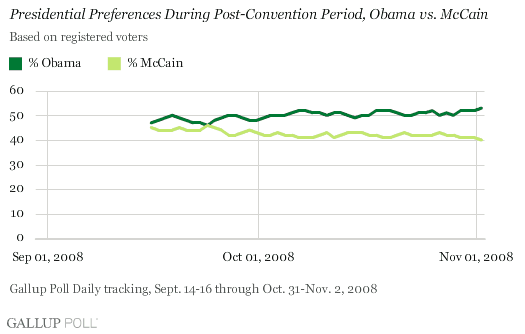PRINCETON, NJ -- Barack Obama's victory over John McCain in the 2008 presidential election concludes a race that was highly competitive for much of the year.

The two were essentially tied during the primary election season, from March through May. Obama moved slightly ahead of McCain once he clinched the Democratic nomination in early June. McCain then succeeded in overtaking Obama after the Republican National Convention in September. But the economic events that followed helped shift voters back into Obama's column, and appear to have been a turning point in the campaign. The presidential debates during the fall may have further strengthened Obama's position, buoying him to double-digit leads among registered voters nationwide in the last few weeks of the campaign.
A Competitive Start
Obama's road to the White House was far from assured during the 2008 primary season when he ran nip and tuck with McCain in early Gallup Poll trial heats for the general election. There were 85 Gallup Poll Daily tracking reports published between March 12 and June 7. McCain was ahead of Obama by one or more percentage points in 39 of those reports, Obama was ahead by one or more points in 31, and they were exactly tied in the remaining 15. The only candidate of the pair to achieve a statistically significant lead during this phase of the campaign was McCain, advancing to five- and six-point leads for a brief period in late April/early May. At that point, the Obama campaign was fighting off a hornet's nest of adverse publicity surrounding Obama's former pastor, the Rev. Jeremiah Wright, as well as Obama's comments about "bitter" voters in Pennsylvania, and his recent primary loss to Clinton in that state.

The closeness of the race in the primary campaign phase of the election year likely can be credited to the then-ongoing Democratic nomination fight, which helped depress Obama's support among Democrats who favored Hillary Clinton for the nomination. Obama's support among Democrats averaged just 75% from March through May, compared with 90% in the final week of the general-election campaign.
By comparison, McCain averaged 86% Republican support from March through May, and finished the campaign at 87% among Republican registered voters.
Summer Winning Streak
After Obama secured the Democratic nomination in early June (Clinton conceded to Obama on June 7), support for him immediately expanded somewhat, resulting in a 75-day stretch (through late August) when he continuously led or tied McCain.
Obama's average lead over McCain during this period was only three percentage points, but it reached as much as nine points in late July after his widely covered trip to parts of Europe and the Middle East.

The Convention Period
Obama's fortunes turned, temporarily, on Aug. 26, when Gallup reported him to be trailing McCain by two percentage points. The Aug. 23-25 interviews on which that report were based represented the first three days of tracking after Obama's announcement of Joe Biden as his running mate. The immediate implication was that his vice-presidential pick, at best, delivered no bounce in support for Obama and, at worst, possibly hurt the ticket. The subsequent Democratic National Convention enabled Obama to turn things back around in his favor. He took the lead again and attained an eight-point advantage over McCain toward the end of the convention.
With the conventions held back-to-back spanning the Labor Day weekend, public preferences seesawed and McCain quickly reversed the Obama tide in early September. McCain moved into the lead immediately after the end of the Republican National Convention, after McCain's, and his vice-presidential running mate Sarah Palin's, highly acclaimed acceptance speeches.
At this point, McCain experienced his longest front-runner stretch of the general-election phase of the campaign: 10 days from Sept. 7 to Sept. 16.

The Economic Game-Changer
McCain's lead came to an abrupt halt with the onset of the Wall Street crisis in mid-September. By Sept. 17, the Republican nominee again trailed Obama by a few percentage points, and while the race briefly closed to a tie later in the month, McCain never regained the lead.
McCain attempted a bold move by suspending his campaign in late September to return to Washington to focus on legislation to address the financial crisis, but he resumed his campaign in time to debate Obama on Sept. 26 even though Congress had not formulated a legislative plan.
The debates were perhaps McCain's best opportunity to reverse Obama's growing momentum, but he was unable to do so. USA Today/Gallup polls found that Americans rated Obama the winner of all three debates, and these may have helped him solidify his gains. October proved to be Obama's best month of the campaign, as he averaged a nine-point lead among registered voters over McCain in Gallup Poll Daily tracking.

Bottom Line
Obama and McCain ran essentially neck and neck for much of the presidential campaign -- from March through early September. Obama enjoyed the slight upper hand once he secured the nomination in early June. But as many observers commented, for a long time he failed to "close the sale" with voters by stretching his lead over McCain to 10 or more points, or by surpassing the 50% support threshold. (He finally reached both of these targets in October.)
Still, as close as the race was, Obama technically held the advantage for much of the year. In 230 Gallup Poll Daily tracking reports from March through Nov. 2, Obama was ahead of McCain in 155 of these (67%), including by a significant margin in 66. McCain had an advantage in only 50 of these reports (22%), and a statistically significant lead in only 6.
McCain pulled ahead briefly after the Republican National Convention. But the economic crisis struck and he failed to "win" any of the three presidential debates in the eyes of Americans. Obama -- who had struck the right chord with voters on the economy and met or exceeded expectations in the debates -- thus ended the campaign running at his strongest level of the entire race.
Survey Methods
Results are based on telephone interviews with 900+ registered voters, aged 18 and older, conducted each day from March 7 through Nov. 2, 2008. The three-day rolling averages of registered voters' preferences have a maximum margin of sampling error of ±2 percentage points.
Interviews are conducted with respondents on land-line telephones (for respondents with a land-line telephone) and cellular phones (for respondents who are cell-phone only).
In addition to sampling error, question wording and practical difficulties in conducting surveys can introduce error or bias into the findings of public opinion polls.
